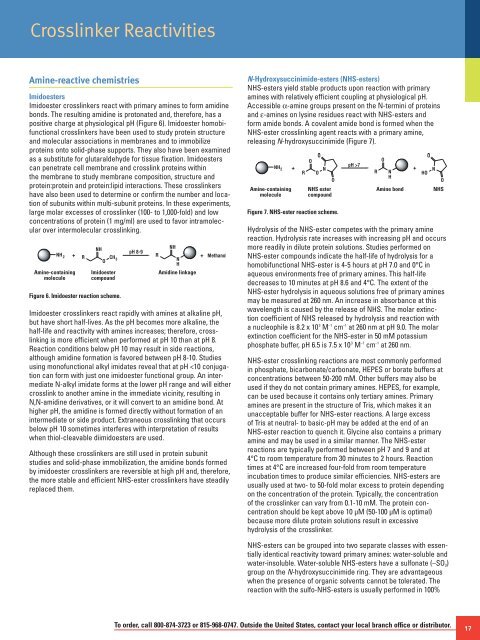Thermo Scientific Pierce Crosslinking Technical Handbook
Thermo Scientific Pierce Crosslinking Technical Handbook Thermo Scientific Pierce Crosslinking Technical Handbook
Single-step vs. Multi-step Reactions Controlled Protein-Protein Crosslinking Kit Contains everything you need to crosslink two proteins and do it successfully. Highlights: • Reliable noncleavable heterobifunctional crosslinking agent offers proven chemistry, highly stable intermediates and efficient formation of the target conjugate • Includes disulfide (S-S) reductants and thiolation reagents • Ellman’s Reagent provides the option to monitor reaction sufficiently References 1. Duncan, R.J.S., et. al. (1983). Anal. Biochem. 132, 68-73. 2. Hashida, S., et. al. (1984). J. Appl. Biochem. 6, 56-63. 3. Hermanson, G.T. (2008). Bioconjugate Techniques. 2nd Ed. Academic Press: London. 4. Imagawa, M., et. al. (1982). J. Appl. Biochem. 4, 41-57. 5. Jocelyn, P.C. (1972). Biochemistry of the SH Group. Academic Press: London, pp. 40-42. 6. Riddle, P.W., et. al. (1983). Methods Enzymol. 91(8), 49-60. Ordering Information Product # Description Pkg. Size 23456 Controlled Protein-Protein Crosslinking Kit Includes: Sulfo-SMCC Crosslinking Agent 10X Activation/Conjugation Buffer BupH Phosphate Buffered Saline 2-Mercaptoethylamine•HCI Immobilized Reductant SATA Dimethylformamide (DMF) Hydroxylamine•HCI Dextran Desalting Column Column Extender Cysteine•HCI Ellman’s Reagent Kit 2 mg 20 ml 2 packs 6 mg 0.2 ml 2 mg 1 ml 5 mg 2 x 10 ml 2 ea. 20 mg 2 mg Activated Dextran Coupling Kit Couple amine-containing ligands and biomolecules. Ordering Information Product # Description Pkg. Size 20890 Aldehyde-Activated Dextran Coupling Kit Includes: Aldehyde-Activated Dextran* [CHO Loading: ~300 moles mole of dextran Sodium Cyanoborohydride BupH Phosphate Buffered Saline Kit 5 x 5 mg 190 mg 1 pack *The average molecular weight of dextran used in these preparations is 40 kDa. Reference Mallia, A.K. and Vigna, R.A. (1998). Previews 1(4), 16-17. Aldehyde-Activated Dextran Average M.W. (dextran) 40 kDa 16 For more information, or to download product instructions, visit www.thermo.com/pierce
Crosslinker Reactivities Amine-reactive chemistries Imidoesters Imidoester crosslinkers react with primary amines to form amidine bonds. The resulting amidine is protonated and, therefore, has a positive charge at physiological pH (Figure 6). Imidoester homobifunctional crosslinkers have been used to study protein structure and molecular associations in membranes and to immobilize proteins onto solid-phase supports. They also have been examined as a substitute for glutaraldehyde for tissue fixation. Imidoesters can penetrate cell membrane and crosslink proteins within the membrane to study membrane composition, structure and protein:protein and protein:lipid interactions. These crosslinkers have also been used to determine or confirm the number and location of subunits within multi-subunit proteins. In these experiments, large molar excesses of crosslinker (100- to 1,000-fold) and low concentrations of protein (1 mg/ml) are used to favor intramolecular over intermolecular crosslinking. Amine-containing molecule Imidoester compound Figure 6. Imidoester reaction scheme. Amidine linkage Imidoester crosslinkers react rapidly with amines at alkaline pH, but have short half-lives. As the pH becomes more alkaline, the half-life and reactivity with amines increases; therefore, crosslinking is more efficient when performed at pH 10 than at pH 8. Reaction conditions below pH 10 may result in side reactions, although amidine formation is favored between pH 8-10. Studies using monofunctional alkyl imidates reveal that at pH
- Page 1 and 2: Thermo Scientific Pierce Crosslinki
- Page 3 and 4: Introduction What is crosslinking C
- Page 5 and 6: Crosslinking Applications Crosslink
- Page 7 and 8: Solid-phase immobilization Proteins
- Page 9 and 10: O NH Biotin HN S SO 3 - Cleavable D
- Page 11 and 12: Sulfo-SBED Reagent Thermo Scientifi
- Page 13 and 14: Figure 3. Applications of Sulfo-SBE
- Page 15 and 16: Structure determination with heavy/
- Page 17: Bioconjugate Toolkit The next gener
- Page 21 and 22: Pyridyl disulfides Pyridyl disulfid
- Page 23 and 24: Phenyl Azide UV Light Nitrene Forma
- Page 25 and 26: Books and Free Technical Handbooks!
- Page 27 and 28: - SH Sulfhydryls X Carbohydrates No
- Page 29 and 30: - SH Sulfhydryls X Carbohydrates No
- Page 31 and 32: - SH Sulfhydryls Carbohydrates Nons
- Page 33 and 34: Appendix I Structures Product # Pro
- Page 35 and 36: Appendix I Structures Product # Pro
- Page 37 and 38: Appendix I Structures Product # Pro
- Page 39 and 40: Appendix I Structures Product # Pro
- Page 41 and 42: Appendix I Structures Product # Pro
- Page 43 and 44: Appendix I Structures Product # Pro
- Page 45 and 46: Appendix I Structures Product # Pro
- Page 47 and 48: Appendix III - Glossary of Crosslin
Crosslinker Reactivities<br />
Amine-reactive chemistries<br />
Imidoesters<br />
Imidoester crosslinkers react with primary amines to form amidine<br />
bonds. The resulting amidine is protonated and, therefore, has a<br />
positive charge at physiological pH (Figure 6). Imidoester homobifunctional<br />
crosslinkers have been used to study protein structure<br />
and molecular associations in membranes and to immobilize<br />
proteins onto solid-phase supports. They also have been examined<br />
as a substitute for glutaraldehyde for tissue fixation. Imidoesters<br />
can penetrate cell membrane and crosslink proteins within<br />
the membrane to study membrane composition, structure and<br />
protein:protein and protein:lipid interactions. These crosslinkers<br />
have also been used to determine or confirm the number and location<br />
of subunits within multi-subunit proteins. In these experiments,<br />
large molar excesses of crosslinker (100- to 1,000-fold) and low<br />
concentrations of protein (1 mg/ml) are used to favor intramolecular<br />
over intermolecular crosslinking.<br />
Amine-containing<br />
molecule<br />
Imidoester<br />
compound<br />
Figure 6. Imidoester reaction scheme.<br />
Amidine linkage<br />
Imidoester crosslinkers react rapidly with amines at alkaline pH,<br />
but have short half-lives. As the pH becomes more alkaline, the<br />
half-life and reactivity with amines increases; therefore, crosslinking<br />
is more efficient when performed at pH 10 than at pH 8.<br />
Reaction conditions below pH 10 may result in side reactions,<br />
although amidine formation is favored between pH 8-10. Studies<br />
using monofunctional alkyl imidates reveal that at pH



